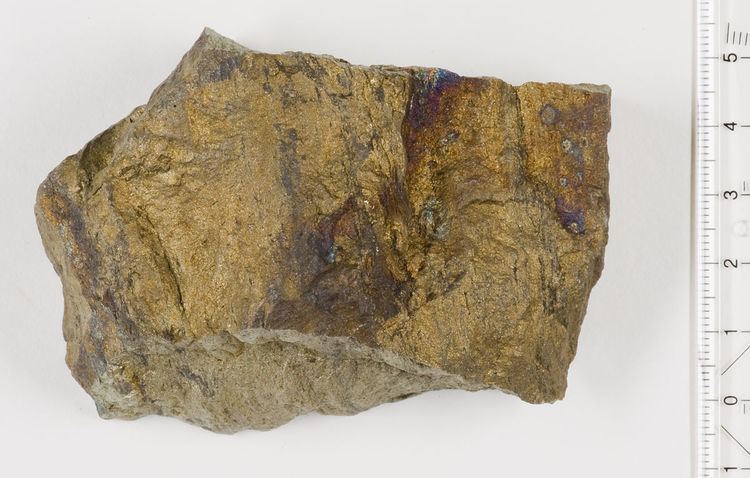 | ||
Sedimentary exhalative deposits (SedEx deposits) are ore deposits which are interpreted to have been formed by release of ore-bearing hydrothermal fluids into a water reservoir (usually the ocean), resulting in the precipitation of stratiform ore.
Contents
- Classification
- Genetic model
- Morphology
- Mineralization types
- Deposition
- Problems of classification
- Sullivan Pb Zn mine
- References
SedEx deposits are the most important source of lead, zinc and barite, a major contributor of silver, copper, gold, bismuth and tungsten.
Classification
The palaeoenvironmental and palaeogeologic setting of these ore deposits sets them apart from other lead, zinc or tungsten deposits which generally do not share the same source or trap morphologies as SedEx deposits.
SedEx deposits are distinctive in that it can be shown that the ore minerals were deposited in a marine second-order basin environment, related to discharge of metal-bearing brines into the seawater. This is distinct from other Pb-Zn-Ag and other deposits which are more intimately associated with intrusive or metamorphic processes or which are trapped within a rock matrix and are not exhalative.
Genetic model
The process of ore genesis of SedEx mineralization is varied, depending on the type of ore which is deposited by sedimentary exhalative processes.
Alternately, SedEx deposits may be sourced from magmatic fluids from subseafloor magma chambers and hydrothermal fluids generated by the heat of a magma chamber intruding into saturated sediments. This scenario is relevant to mid-ocean ridge environments and volcanic island arcs where black smokers are formed by discharging hydrothermal fluids.
Morphology
Upon mixing of the ore fluids with the seawater, dispersed across the seafloor, the ore constituents and gangue are precipitated onto the seafloor to form an orebody and mineralization halo which are congruent with the underlying stratigraphy and are generally fine grained, finely laminated and can be recognized as chemically deposited from solution.
Arkose-hosted SedEx deposits are known in some cases, associated with arkosic strata adjacent to faults which feed heavy brines into the porous sands, filling the matrix with sulfides, or deposited within a predominantly arkosic layer as a distinct chemical sediment layer usually associated with a shale interbed or at the lowermost levels of a shale formation directly overlying arkosic sands (for example, copper deposits near Maun, Botswana).
Occasionally, mineralization is developed in faults and feeder conduits which fed the mineralizing system. For instance, the Sullivan orebody in south-eastern British Columbia was developed within an interformational diatreme, caused by overpressuring of a lower sedimentary unit and eruption of the fluids through another unit en route to the seafloor.
Within disturbed and tectonized sequences, SedEx mineralization behaves similarly to other massive sulfide deposits, being a low-competence low shear strength layer within more rigid silicate sedimentary rocks. As such, boudinage structures, dikes of sulfides, vein sulfides and hydrothermally remobilized and enriched portions or peripheries of SedEx deposits are individually known from amongst the various examples worldwide.
Mineralization types
SedEx mineralization is best known in lead-zinc ore deposit classification schemes as the vast majority of the largest and most important deposits of this type are formed by sedimentary-exhalative processes.
However, other forms of SedEx mineralization are known;
Deposition
The mineralizing fluids are conducted upwards within sedimentary units toward basin-bounding faults. The fluids move upwards due to thermal ascent and pressure of the underlying reservoir. Faults which host the hydrothermal flow can show evidence of this flow due to development of massive sulfide veins, hydrothermal breccias, quartz and carbonate veining and pervasive ankerite-siderite-chlorite-sericite alteration.
Fluids eventually discharge onto the seafloor, forming areally extensive, stratiform deposits of chemical precipitates. Discharge zones can be breccia diatremes, or simple fumarole conduits. Black smoker chimneys are also common, as are seepage mounds of chert, jaspilite and sulfides.
Problems of classification
One of the major problems in classifying SedEx deposits is in identifying whether or not the ore was definitively exhaled into the ocean and whether the source was formational brines from sedimentary basins.
In the majority of cases the overprint of metamorphism and faulting, generally thrust faulting, deforms and disturbs the sediments and obscures sedimentary features, although this is generally patchy so that the original configuration will be seen within the deposit.
Most deposits fit the model of having been formed late in the basin history and in most cases feeder systems and metal zonation support exhalative models. However, in the case of diatreme related deposits, such as the giant low-grade Abra deposit, the mineralization is intra-formational, lacks sedimentary textures (is epigenetic and replacement type) and is too low in the basin profile (i.e. in the basal formation).
Following the discovery of hydrothermal vents, deposits similar to those of oceanic vents and fossilized vent life forms have been found in some SedEx deposits, which leads to a potential degree of overlap between Sedex and Volcanogenic massive sulfide ore deposits.
Sullivan Pb-Zn mine
The Sullivan Pb-Zn Mine in British Columbia was worked for 105 years and produced 16,000,000 tonnes of lead and zinc, as well as 9,000 tonnes of silver. It was Canada's longest lived continuous mining operation and produced metals worth over $20 billion in terms of 2005 metal prices. Grading was in excess of 5% Pb and 6% Zn.
The ore genesis of the Sullivan ore body is summarized by the following process:
